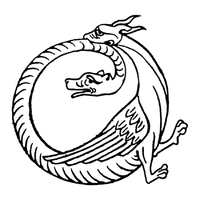Amphisbaena
The amphisbaena (/ˌæmfɪsˈbɛɪnə/, /ˌæmfɪsˈbaɪnə/, or /ˌæmfɪsˈbiːnə/, plural: amphisbaenae; Ancient Greek: ἀμφίσβαινα) is a mythological, ant-eating serpent with a head at each end. The creature is alternatively called the amphisbaina, amphisbene, amphisboena, amphisbona, amphista, amfivena, amphivena, or anphivena (the last two being feminine), and is also known as the "Mother of Ants".[not verified in body] Its name comes from the Greek words amphis, meaning "both ways", and bainein, meaning "to go".[not verified in body]
According to Greek mythology, the amphisbaena was spawned from the blood that dripped from the Gorgon Medusa's head as Perseus flew over the Libyan Desert with her head in his hand, after which Cato's army then encountered it along with other serpents on the march.[1] Amphisbaena fed on the corpses left behind. The amphisbaena has been referred to by various poets such as Nicander, John Milton, Alexander Pope, Percy Bysshe Shelley, Alfred Tennyson, Aimé Césaire, A. E. Housman and Allen Mandelbaum; as a mythological and legendary creature, it has been referenced by Lucan, Pliny the Elder, Isidore of Seville, and Thomas Browne , the last of whom debunked its existence ("Pseudodoxia Epidemica".book three chapter XV).
The amphisbaena has a twin head, that is one at the tail end as well, as though it were not enough for poison to be poured out of one mouth.
The Amphisbaena however is a snake with two heads, one at the top and one in the direction of the tail. When it advances, as need for a forward movement impels it, it leaves one end behind to serve as tail, while the other it uses as a head. Then again if it wants to move backwards, it uses the two heads in exactly the opposite manner from what it did before.
The amphisbaena grows twin heads, one in the proper place, and the other where the tail should be. For this reason the snake glides in a circular shape, as the heads, contrary to what is right, strain from both ends.
These early descriptions of the amphisbaena depict a venomous, dual-headed snakelike creature. However, medieval and later drawings often show it with two or more scaled feet, particularly chicken feet, and feathered wings.[citation needed] Some[who?] even depict it as a horned, dragon-like creature with a serpent-headed tail and small, round ears, while others have both "necks" of equal size so that it cannot be determined which is the rear head.[citation needed] Many descriptions[by whom?] of the amphisbaena say its eyes glow like candles or lightning, but the poet Nicander seems to contradict this by describing it as "always dull of eye". He also says: "From either end protrudes a blunt chin; each is far from each other." Nicander's account seems to be referring to what is indeed called the Amphisbaenia, a group of real lizards.[citation needed]



